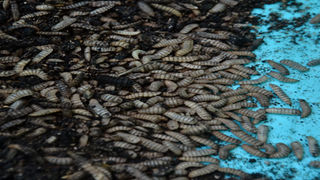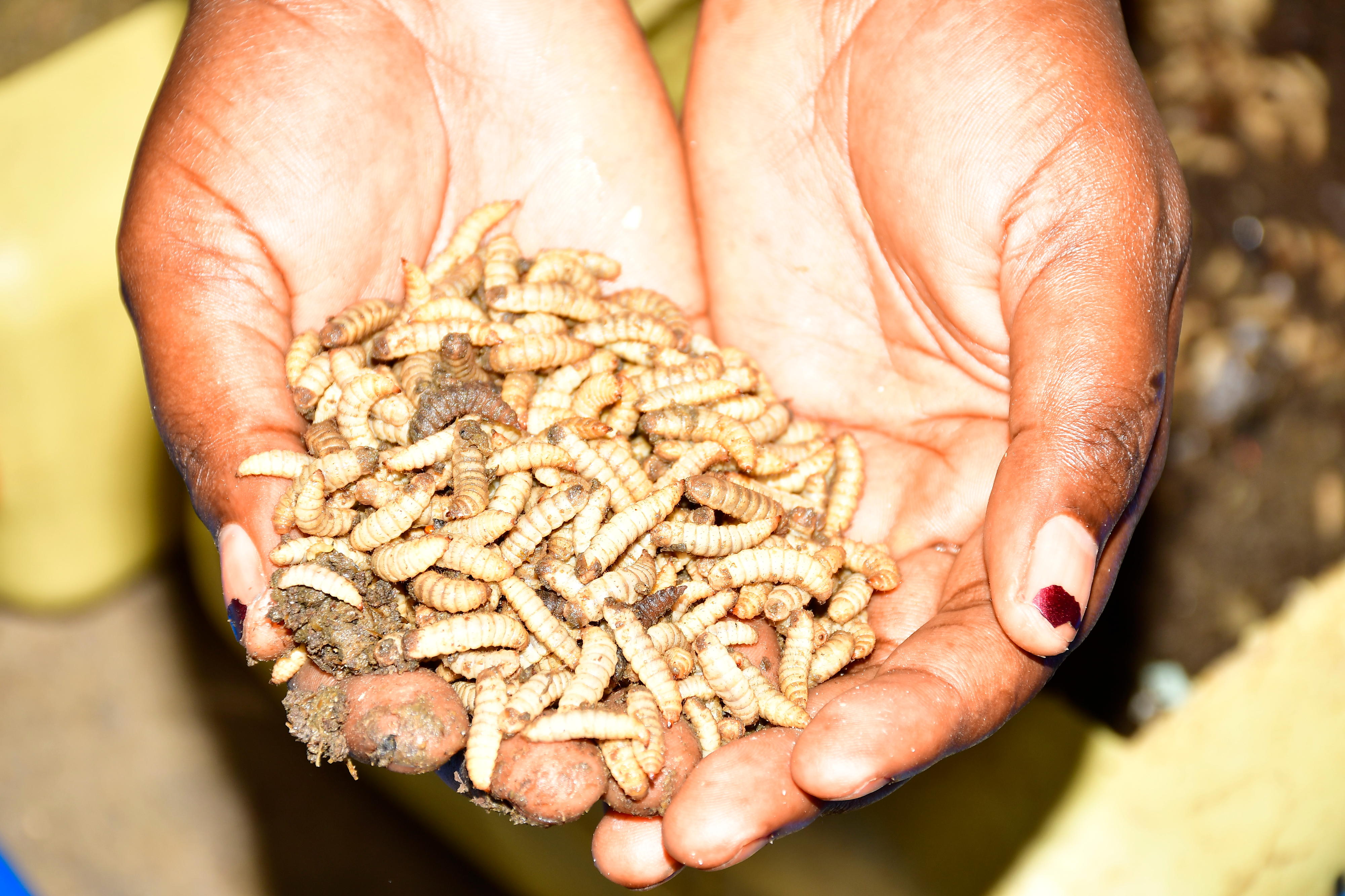
To extract oil, a farmer must crush these lavae. PHOTO/GEORGE KATONGOLE
|Farming
Prime
How to start your own Black Soldier Fly farm
What you need to know:
- There are three requirements for a Black Soldier Fly farm; a bin, larvae and the organic waste.
- For novices who have a keen interest in insect farming, it is more cost-effective to rear their own Black Soldier Fly eggs into larvae which will in turn enable them to create a profitable and scalable business.
Although other raw materials can be used as alternative just like we have been reporting in these pages, there is increasing focus on Black Soldier Fly (BSF) larvae because of its numerous benefits.
The black soldier fly larvae contain 45 percent protein needed by fish, poultry and piggery in the feed formulation.
Besides, the manufacture is easy to do with low and affordable production costs because the main medium is organic waste.
The feed can be used live, particularly for poultry and pigs. It can also be dried and further processed into a protein meal. The larvae are composed of at least 40 percent protein and 30 percent crude fat.
Most benefits are accrued. From the oven dried larvae flies, oil can also be produced. The oil is mechanically pressed out of the dry larvae, to provide a high fat oil, otherwise only found in coconut and palm kernel oils.
This oil can be used in a variety of livestock, aquaculture and pet manufactured feed products.
The residue, a substance similar to compost, called frass, contains nutrients and organic matter and, when used in agriculture, helps to reduce soil depletion.
Feasible
A research report on the business analysis of black soldier fly (BSF) as an alternative feed for fish cultivation in Bogor City, Wales released in 2021 estimates that 100 kilogrammes of raw material for culture media can produce larvae as much as 60-70 kilogrammes in just two weeks.
Therefore, when compared with pellet feed, the BSF larvae can help farmers save at least 22 percent on feed costs. If the whole feeding process uses 100 per cent larvae, it is very profitable because it can save feed costs by 45 per cent. With this amount of feed savings, in terms of quality and quantity, larvae have the potential to substitute feed on farms.
Yet BSF farming can be done without many of the traditional and expensive elements required to be a farmer. It is ideal for a peri-urban type setting as one does not need a lot of land.
Since BSF farms do not require much space, setting up an enterprise of this nature is fairly accessible to average farmers.
According to Salim Ndale, a production manager with Proteen, the first industrial black soldier fly production company in Uganda, there are three requirements for a BSF farm; a bin, larvae to start off the operation, and the organic waste.
Ndale explains that due to the high demand of BSF larvae, feed and fertiliser, farmers need to operate their own farms to supply their own farm requirements.
He says that aspiring farmers must be willing to get dirty, to deal with food waste and to deal with insects. He says the farmers also need some undercover space such as the garage.
Getting it right
Differences in nutrition in the feed will cause various nutritional content of larvae in terms of proteins and fat. The highest average protein content is found in tomatoes and the highest average fat content is found in carrot media.
The larvae feed mainly on low-fibrous waste; overripe fruit, vegetables and some leaves such as cabbage. Since it does not have a chewing device, access to nutrients is easier if the substrate is composed of small pieces or even in liquid or pasty form.
Ndale says that the nutrition of BSF larvae is strongly influenced by the media in which they breed. If the media is rich in protein, larvae will contain high protein, and the same thing happens with media with high levels of fat or fibre.
The facilities
The BSF facility has five main units including; the rearing unit, waste receiving and pre-processing unit, waste treatment unit, harvesting unit and post-treatment unit which is essential for larvae refining and residue processing. The main costs involved include starter larvae, labour, power availability and water. In brief Ndale says that to have a fully functional facility, it takes less than Shs1m to have everything in place.
The materials used largely depend on the support used to build the living space of larvae. This can be done in a wooden box, a drum cut in half or a large plastic box.
To construct the breeding box, there is no need for sophisticated technology to operate such a facility which makes it suitable for low-income settings that rely mostly on simple technology and unskilled labour.
The breeding environment can be made with various materials. Ndale says that one can use a plastic drum cut on top, or a simple plastic box. The sides of the waste bin may need an additional barrier against larvae escape.
These units should take into consideration the life cycle of black soldier flies. They include the larval stage where the BSF larvae feed in order to make a sufficient fat reserve to be able to transform into pupae, then into a fly and reproduce.
During its life, the larva takes 5,000 times its initial mass. At this stage, the larvae are white in colour and will grow from a few millimetres to 2.5cm in length.
Its environment will be limited to the waste you give it; in which it will bury itself to feed. This stage lasts between 14 and 16 days. For larvae, the ideal temperature should be between 24 and 30°C.
“If it is too hot, the larvae will move away from the food in search of a cooler place. If it is too cold, the larvae will slow their metabolism, eat less and develop more slowly,” he says.
Ndale adds that larvae tend to avoid light and always seek a shaded environment, away from sunlight. If their food source is exposed to light, they will move deeper into the food layer to escape the light. At the pre-pupae stage, the larvae get out of the wet environment to reach a dry place to transform into pupae.
This process will take between two and three weeks. The fly will live about one week and does not need to feed, only a source of water will be needed to keep her hydrated.
A farmer needs to plan for nests where females will lay their eggs. Nests can be made from honeycomb cardboards.
“The lifecycle of the fly is very short, so the mating conditions must be met quickly,” Ndale explains.
The larvae can be harvested after two weeks as their nutritional value is at its highest. The larvae are separated from the residue manually or with an automated screen that separates larvae from residues. Ndale says it is preferable to use a sieve with large mesh sizes. The harvested larvae can be fed directly to animals or dehydrated to preserve them. The organic waste residue (frass) can be dried in the sun and used as compost.
Profitability
Producing black soldier fly larvae can diversify farmers’ income streams and help them to increase the circularity and sustainability of their operations.
A 2021 Dutch study on the profitability potential of black soldier fly larvae at farm level funded by Wageningen University, states that the process is not completely cut and dry because there seems to be specific parameters that determine whether this may or may not be financially viable.

A farmer displays oil extracted from Lavae. PHOTO/GEORGE KATONGOLE
The first thing to notice is that the potential for BSF larvae seems to be higher when the larvae can be sold live.
A kilogramme of black soldier fly larvae cost Shs650. By drying larvae, a lot of water and body weight evaporates. This means that the price of dried larvae needs to be significantly higher than the price for live larvae to make up for this weight loss by taking into account the processing and energy costs.
Ndale advises farmers to sell their product directly to consumers instead of selling through animal shops.
The cost of starter larvae is also an important influence on profitability. In order to make profit, farmers need to breed their own starter larvae.
“The bottom line is for farmers to find a way that increases profitability of their operations,” Ndale says.
BSF unit
The BSF facility has five main units including; the rearing unit, waste receiving and pre-processing unit, waste treatment unit, harvesting unit and post-treatment unit which is essential for larvae refining and residue processing.




